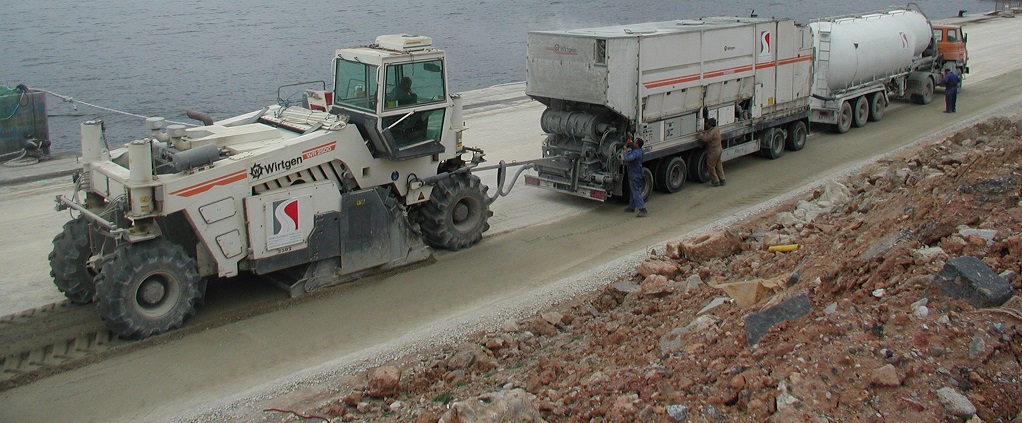Soil improvement & stabilisation
EUPAVE is proud to present the leaflet “Soil stabilisation & In-situ pavement recycling”. In this publication you will find information concerning in-situ pavement recycling with cement, soil stabilisation and binders.
Description
Treatment of soil with a binding agent (lime, cement, cementitious road binder) consists of incorporating this binder into the soil, possibly with the addition water, and mixing more or less intimately, generally in situ, until obtaining a material which is homogeneous enough to possess new properties. This technique uses the chemical similarities of the soil and the binder, as opposed to a mechanical treatment only, such as compaction.
Advantages
Treatment of soils offers technical, economic, ecological and environmental advantages.
Technical advantage
Treatment with lime and/or cement or cementitious road binders allows production and use of homogeneous, long-lasting and stable materials with mechanical characteristics comparable to those of graded aggregate with cementitious binders.
In addition, these materials are characterised by great stiffness and excellent fatigue strength. They show good performance in hot weather, with no deformation or rutting, and good performance on exposure to freeze-thaw cycles due to the stiffness of the material and the slab-side effect.
Economic advantage
Field recycling is a significant savings factor as this reduces to a minimum stripping cuts, landfill, provision of aggregates and thus the cost of their transport. The absence of transport of aggregates and of cuts to the landfill contributes to preserving the road network in the vicinity of the building site.
Also, these are very economical techniques, especially on account of the shorter duration of the works: compared to a conventional solution, the savings are of the order of 30%.
Ecological and environmental advantage
Cold treatment reduces pollution and discharge of fumes into the atmosphere. Moreover this technique allows significant global energy savings by reducing the transport of materials, the quantity of materials for landfill (thus limiting indirect effects – nuisance to users and residents) and fatigue of the road network adjacent to the site.
Field recycling minimises exploitation of aggregates deposits (quarries and gravel pits), non-renewable natural resources. This contributes to preserving the environment.
Applications
Soil treatment is used to make embankments, capping layers, base courses of transportation infrastructures such as roads, TGV (train à grande vitesse, high-speed trains) foundations, industrial and airport foundations.
The soils treated are subject to several European standards:
- EN 14 227-10: Mixtures treated with cementitious binders -Specifications-Part 10: Cement-bound soil
- EN 14 227-13: Mixtures treated with cementitious binders – Specifications-Part 13: Soil treated with Cementitious Road Binder.
A distinction is generally made between:
- Treatment for soil improvement, which aims to modify the characteristics of materials, generally the moisture content, to facilitate their use.
This type of treatment is appropriate for a short-term objective. - Treatment for soil stabilisation, which aims to increase performance in resisting, in particular, mechanical and climatic stresses and increase the service life of the structure.
This type of treatment is appropriate for a long-term objective.
Benefits
The growing use of brownfield sites and the focus on sustainability issues bring increasing recognition of the benefits of soil stabilisation:
- Speed of project completion;
- Reduced use of imported aggregates;
- Less local construction traffic;
- Reduced project costs;
- The provision of an economic and effective sub base;
- The ability to deal with sulphate-bearing soils.


